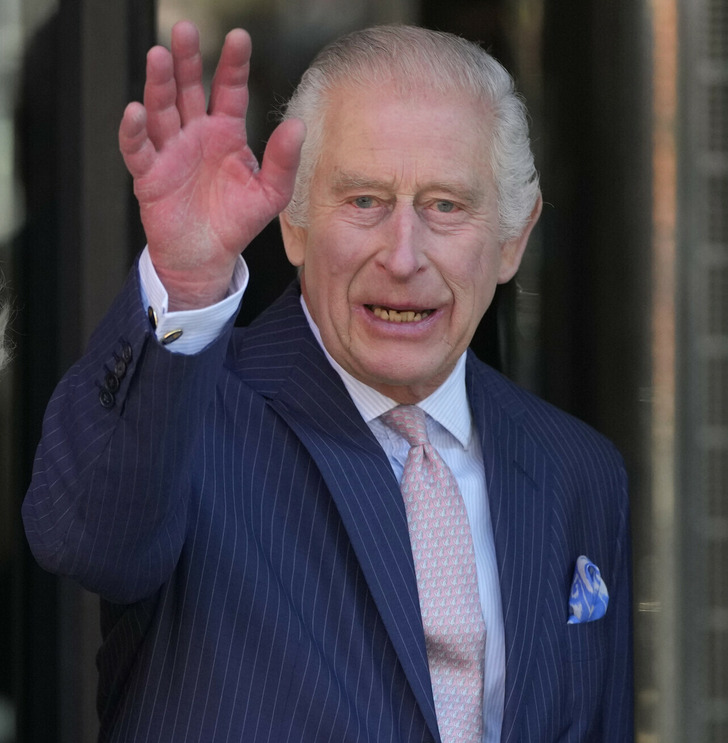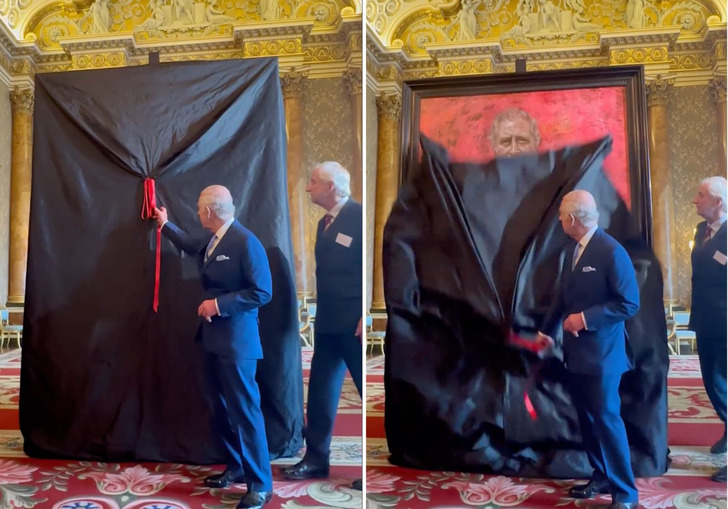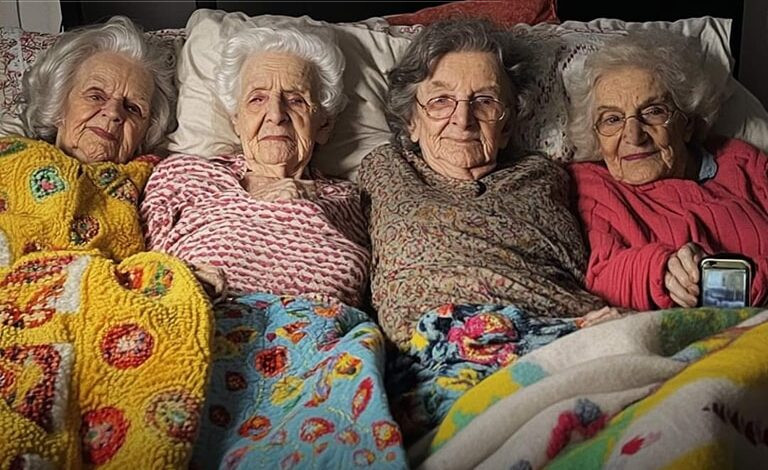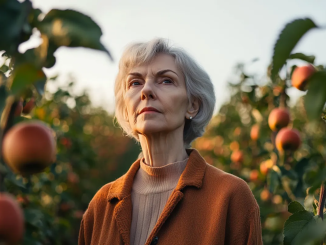In a dramatic unveiling that has left the public and critics buzzing, King Charles III revealed his first official portrait since ascending to the throne, and reactions have been anything but tepid. As debates rage on social media and in art circles, it is clear that King Charles’ portrait is destined to be one of the most talked-about royal artworks in recent history.
The unveiling

Recently, King Charles III personally unveiled a new portrait of himself at Buckingham Palace, the first such portrait since his coronation. The Royal Family’s Instagram account shared an exclusive video of the unveiling, featuring the king himself presenting the artwork.
This significant new work will ultimately be displayed in Drapers’ Hall in London, adding to its historical art collection and offering the public a glimpse of the monarch’s regal presence.
There was an ongoing debate in the comments.

The unveiling sparked a heated debate in the comments section on the Royal Family’s Instagram post and other social media sites. Opinions were sharply divided, with some users harshly criticizing the artwork. Comments ranged from “That is hideous” and “Without sounding rude, this is the worst royal portrait I’ve ever seen” to “100% thought this was satire.”
One critic remarked, “The face is good, the rest is appalling,” while another noted, “I would have loved this if it was any other color than red. He really captured the essence of him in the face, but the harshness of the red doesn’t match the softness of his expression.”
Despite the criticism, there were also voices of appreciation, such as “A lovely portrait of King Charles! I love the way the muted background draws attention to his face!” The mixed reactions highlight the polarizing nature of the portrait and the strong emotions it has evoked among the public.
The artist
Jonathan Yeo, a prominent figure in the world of figurative painting, has earned widespread acclaim for his unique blend of traditional and experimental portraiture. Yeo’s distinctive approach involves a deep engagement with his subjects, allowing him to capture their essence beyond mere physical appearance.
His recent portrait of King Charles III epitomizes this philosophy. Yeo explained, “As a portrait artist, you get this unique opportunity to spend time with and get to know a subject, so I wanted to minimize the visual distractions and allow people to connect with the human being underneath.”
The meaning of the portrait.
A particularly striking element of Yeo’s portrait is the inclusion of a butterfly. This detail serves multiple purposes, both symbolic and compositional. Yeo elaborated, “Primarily a symbol of the beauty and precariousness of nature, it highlights the environmental causes the King has championed most of his life and certainly long before they became a mainstream conversation.”
The butterfly also provides a visual contrast to the uniform, softening the portrayal and adding layers of meaning. “In the context of art history, a butterfly often symbolizes metamorphosis and rebirth, paralleling the King’s transition from Prince to monarch during the period the portrait was created,” Yeo noted, further emphasizing the transformative phase in King Charles’s life.

Yeo expressed his gratitude and honor for being commissioned to create such a significant portrait. “It was a privilege and pleasure to have been commissioned by The Drapers’ Company to paint this portrait of His Majesty The King, the first to be unveiled since his Coronation.”
Yeo’s approach to portraiture aims to encapsulate the life experiences and humanity etched into his subjects’ faces. “I do my best to capture the life experiences and humanity etched into any individual sitter’s face, and I hope that is what I have achieved in this portrait,” he explained.
The challenge of portraying a figure as complex and significant as King Charles III was substantial, but one that Yeo found immensely rewarding. “To try and capture that for His Majesty The King, who occupies such a unique role, was both a tremendous professional challenge, and one which I thoroughly enjoyed and am immensely grateful for,” he concluded. The portrait, destined for Drapers’ Hall in London, stands as a testament to both the artist’s skill and the monarch’s enduring legacy.
Discover the lesser-known facets of King Charles III’s life in our compelling article, “8 Things About King Charles III That Will Allow Us to Know Him More Closely.” Dive beyond the regal exterior to uncover intimate details about his passions, personal experiences, and unique quirks.
Preview photo credit Kin Cheung / Associated Press / East News, theroyalfamily / Instagram, jonathanyeo / Instagram
Poor Nurse Takes Care of 4 Elderly Sisters, Learns Their Will after They All Die

A poor nurse named Cassandra Myers lived a modest life while working at a local hospital. Although nurses generally earn decent wages in America, Cassandra found herself struggling financially because much of her income went toward paying off her late parents’ debts. She resided in her ancestral home, located in a peaceful neighborhood where her only nearby companions were four elderly siblings, all in their 80s.Cassandra often observed these elderly neighbors struggling with daily tasks like carrying groceries, cleaning their house, taking out the trash, and preparing meals. Realizing that they were in need of assistance, she offered her help whenever she returned from her hospital shifts. The four sisters appreciated her efforts and enjoyed her company immensely. One day, the eldest sister, Marie, expressed her gratitude, suggesting they pay Cassandra for her help.
However, Cassandra kindly refused, explaining that she was helping them out of care and not for financial gain. She made it a point to assist them daily, cooking their meals, washing dishes, organizing their medications, and even helping them get dressed. During one dinner together, Cassandra asked why the sisters hadn’t considered moving to a nursing home, where they could receive better care. Clara, one of the sisters, revealed that they had chosen to stay together in their own home rather than be separated in a nursing facility. They valued spending their remaining days surrounded by genuine love and care, which they felt might not be present in a nursing home environment.Understanding their perspective, Cassandra reassured them that she would always be there to help. The sisters were deeply touched by her kindness, with one of them remarking that she was the best neighbor anyone could ask for. Despite her exhaustion from work, Cassandra remained committed to visiting the siblings every day, sharing meals with them and tending to their needs. Sadly, as time passed, the sisters began to pass away one by one. Cassandra mourned each loss deeply and took it upon herself to organize their funerals. After the last sister passed away, Cassandra attended the funeral, where she met a lawyer named Abigail Smith. The lawyer expressed her gratitude to Cassandra for taking care of the sisters and informed her that there was something important she needed to discuss. The following day, Cassandra visited Abigail’s office, where she was handed a document. The lawyer explained that the sisters had children living in nearby states, but these children had not bothered to attend any of the funerals. Hurt by their children’s neglect, the sisters had decided to change their will, leaving everything to Cassandra instead.Cassandra was stunned by this revelation. She never expected to inherit the sisters’ estate, which included money, jewelry, and the house. Although she felt undeserving, Abigail reassured her that the sisters saw her as more of a daughter than their own children, making her the rightful heir. The inheritance was more than enough for Cassandra to pay off her parents’ debts, but the situation became complicated when the sisters’ children learned about the will. Initially, they wanted to contest it in court, but before they could proceed, Attorney Abigail sent them letters from their mothers. These letters, identical for each child, expressed the mothers’ love but also their deep disappointment over being neglected in their later years. The letters explained that the mothers had left their fortune to someone who had been there for them when their children were not. Upon receiving the letters, the children decided to withdraw their lawsuit. They realized how poorly they had treated their mothers and accepted that they did not deserve any part of the inheritance.Though Cassandra never met the sisters’ children, she noticed fresh flowers on the women’s graves each year on their death anniversaries. This small gesture brought her comfort, knowing that the sisters’ children were finally honoring their mothers, even if it was too late.



Leave a Reply